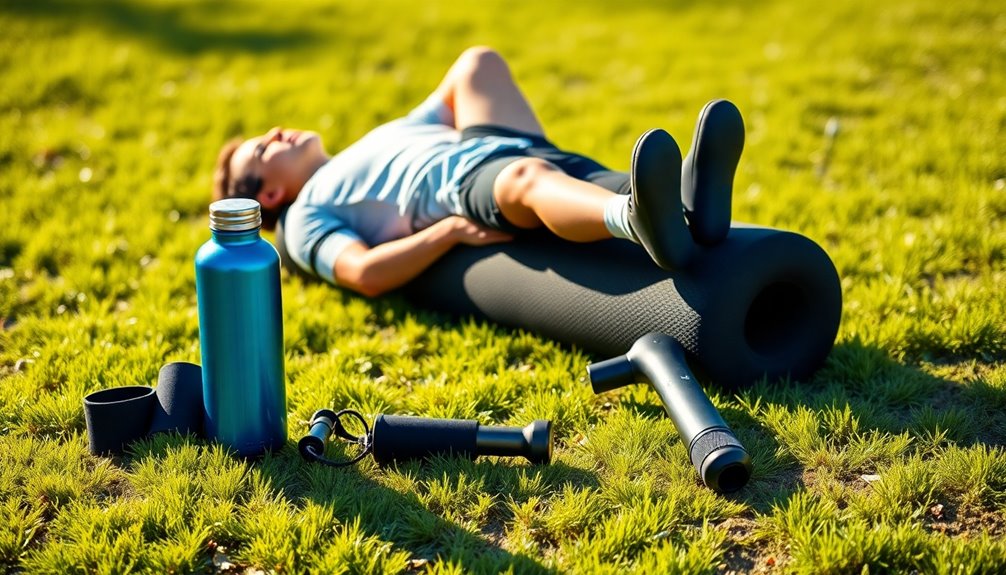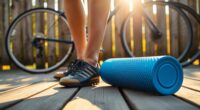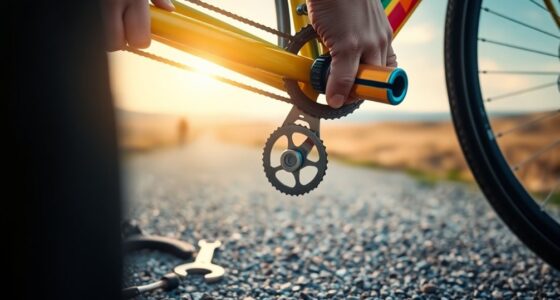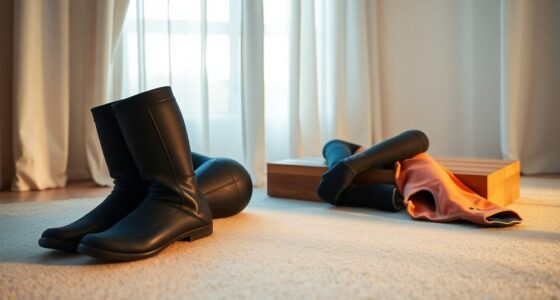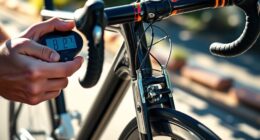Recovery is essential for your performance as a cyclist. You need to allow 1 to 3 days of recovery based on workout intensity, listen to your body's signals, and prioritize sleep—aim for 8-9 hours each night. Nutrition plays a key role; post-ride snacks should include protein and carbs. Incorporate techniques like foam rolling, massage, and proper hydration to enhance your recovery. Stick around to discover the best practices and tools to boost your cycling recovery even further.
Key Takeaways
- Prioritize sleep by aiming for 8-9 hours each night to enhance muscle repair and overall recovery.
- Incorporate sports massage and foam rolling to reduce muscle soreness and improve flexibility post-ride.
- Consume a post-ride snack with 20-30g of protein and 30-50g of carbohydrates within 30 minutes for optimal nutrient uptake.
- Stay hydrated and replenish electrolytes to support recovery and maintain performance levels.
- Regularly assess key muscle groups like the hamstrings and glutes to tailor recovery routines effectively.
Understanding the Importance of Recovery

When you push your limits on the bike, it's easy to overlook the importance of recovery. However, recovery is vital for muscle repair and growth. Most athletes are under-recovered, as workouts break down your body, and it's during recovery that rebuilding happens.
Incorporating recovery rides at low intensity helps maintain muscle activity and circulation without adding fatigue. You should also focus on nutrition; post-ride recovery drinks with 20-30g of protein and 30-50g of carbohydrates effectively support muscle repair.
Don't forget about recovery time—generally 1-3 days, depending on training intensity and overall health. Prioritizing sleep is essential, too; aim for 8-9 hours a night to enhance recovery and improve performance.
Recovery Time and Listening to Your Body

How can you tell when it's time to take a break? Understanding your recovery time is key. For most cyclists, this typically ranges from 1 to 3 days, influenced by workout intensity and personal stress levels.
Listening to your body is essential; signs like fatigue, soreness, or decreased performance signal that you might need extra recovery time beyond your planned rest days.
Overtraining can wreak havoc on your immune and nervous systems, making it important to evaluate your energy levels and overall well-being.
Remember, recovery isn't just about your legs; it requires a holistic approach that addresses your entire body.
Regularly reviewing your recovery progress helps you identify what works best for you, optimizing your performance in the long run.
Rest Days and Recovery Practices
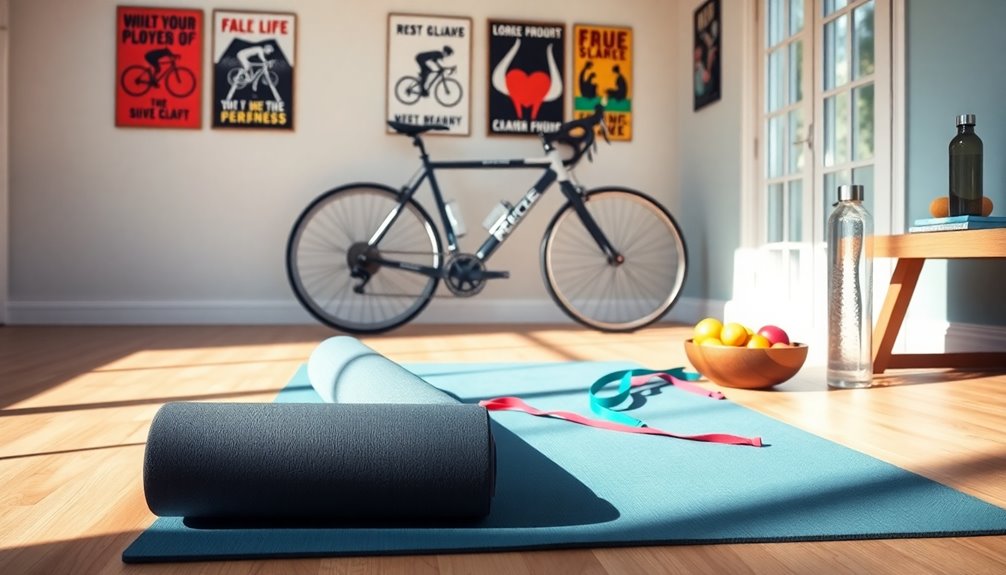
While you might be tempted to push through your training plan, incorporating regular rest days is vital for ideal recovery and performance. Taking 2-3 solid rides before a complete rest day allows your body to recover effectively while maintaining fitness levels.
On rest days, avoid high-intensity activities; instead, focus on complete rest or very easy spinning. Pro cyclists often engage in recovery rides of 60-90 minutes at a low intensity to keep muscle activity flowing and prepare for upcoming workouts.
Active recovery rides in Zone 1 enhance muscle recovery by promoting blood flow and eliminating waste products from previous hard sessions. Regularly scheduled rest days and lower volume weeks are essential for long-term performance and preventing muscle damage.
Nutrition Guidelines for Recovery

After your ride, focusing on nutrition is key to recovery.
You should aim for a post-ride snack that balances protein and carbs to aid muscle repair and replenish energy.
Don't forget to hydrate, as replacing lost fluids is essential for getting back on your bike feeling your best.
Post-Ride Snack Essentials
To maximize your recovery after a cycling session, it's essential to focus on your post-ride snack. Aim for a mix of 20-30 grams of protein and 30-50 grams of carbohydrates to effectively replenish glycogen stores. Nutrient-dense options include a protein shake with banana or chicken and rice. Don't forget about hydration; drink fluids that replace lost electrolytes, especially after intense rides. It's best to consume your recovery snack within 30 minutes post-ride to optimize nutrient uptake. Including foods rich in antioxidants, like berries, can further support your recovery. Additionally, keeping an eye on your budget for nutrition can help you make healthier choices without overspending.
| Protein Source | Carb Source | Antioxidant Source |
|---|---|---|
| Protein shake | Banana | Berries |
| Chicken | Rice | Leafy greens |
| Greek yogurt | Oats | Dark chocolate |
| Cottage cheese | Quinoa | Chia seeds |
Nutrient Timing Importance
Recovery isn't just about what you eat after a ride; it's also about when you eat it. Proper nutrient timing can greatly enhance your muscle repair and overall recovery.
Aim to consume a recovery snack with 20-30g of protein and 30-50g of carbohydrates within 30 minutes post-ride. This helps replenish glycogen stores efficiently.
Don't forget about hydration—replenishing fluids right after your ride is essential for preventing dehydration and supporting recovery processes.
Additionally, including antioxidant-rich foods in your post-ride meals can reduce inflammation and speed up recovery.
Remember, maintaining balanced nutrition throughout the day, not just after rides, is fundamental for ongoing performance improvement and effective recovery.
Prioritize timing, and you'll see the benefits on your next ride.
Hydration for Recovery
Hydration plays an essential role in your recovery process, ensuring you replace fluids lost during cycling and support muscle function.
To optimize your hydration, follow these guidelines:
- Drink Water & Electrolyte-Rich Beverages: Sip fluids before, during, and after rides to maintain hydration levels.
- Monitor Urine Color: Aim for pale yellow urine to indicate good hydration; dark yellow suggests dehydration.
- Post-Ride Fluid Intake: Consume fluids immediately after cycling, aiming to replace about 1.5 liters for every kilogram lost during exercise.
- Include Sodium & Potassium: Opt for electrolyte drinks to replenish lost electrolytes and prevent muscle cramping.
Sleep and Its Role in Recovery

When it comes to recovery, sleep is your secret weapon.
Aim for 8-9 hours each night to boost muscle repair and overall performance.
Plus, implementing strategies to improve sleep quality and adding short naps can make a real difference in how you feel during your rides.
Sleep Duration Guidelines
Getting enough sleep is essential for cyclists aiming to optimize their recovery and performance.
To enhance your sleep duration and quality, consider the following guidelines:
- Aim for 8-9 hours of sleep each night to improve recovery and athletic performance.
- Manage stress levels, as higher stress may require longer sleep durations for effective recovery.
- Use sleep tracking devices like Whoop or Oura to monitor your sleep quality and guarantee you're meeting your recovery needs.
- Unplug from technology at least 1-2 hours before bedtime to enhance sleep onset and quality.
Sleep Quality Improvement Tips
To enhance your recovery, focusing on sleep quality is just as important as getting enough hours of rest. Professional riders prioritize 7-9 hours of quality sleep each night to boost recovery day performance. Here are some tips to improve your sleep quality:
| Tip | Description |
|---|---|
| Unplug from technology | Disconnect 1-2 hours before bedtime to reduce blue light. |
| Use sleep tracking devices | Utilize tools like Whoop or Oura to monitor your sleep. |
| Establish a routine | Create a consistent bedtime routine with relaxation techniques. |
| Incorporate naps | Take 20-60 minute naps after long rides to aid recovery. |
| Follow training plans | Align your sleep schedule with your training plans for best results. |
Napping for Recovery Benefits
Improving your sleep quality is only part of the recovery equation; napping can play a significant role in enhancing your overall performance. Incorporating napping into your routine can provide multiple recovery benefits, especially after a long ride.
Here's how napping can help:
- Alleviates Fatigue: A 20-60 minute nap can help you recover from fatigue.
- Boosts Cognitive Function: Napping enhances your focus, essential for training and racing.
- Aligns with Circadian Rhythms: Mid-afternoon naps fit well with your body's natural rhythms.
- Offsets Sleep Deprivation: Regular napping can counteract the effects of not getting 8-9 hours of sleep, as noted in sports medicine studies.
To maximize benefits, nap in a dark, quiet environment, and avoid napping too close to bedtime.
Recovery Techniques and Supplements
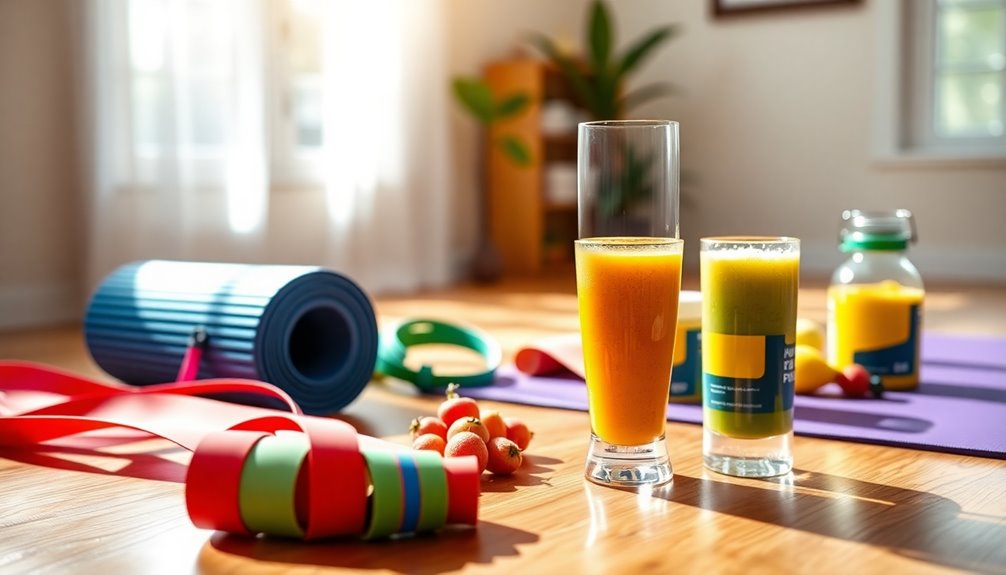
As you push your limits on the bike, effective recovery techniques and supplements become essential for maintaining peak performance.
Incorporating sports massage into your routine can greatly reduce muscle soreness and tension, enhancing your overall recovery.
After your ride, utilizing foam rolling helps break down adhesions and promotes better flexibility, reducing stiffness in your muscles.
Utilizing foam rolling post-ride breaks down adhesions and enhances flexibility, effectively reducing muscle stiffness.
Compression boots can accelerate blood flow and waste removal, further improving recovery time.
Don't forget about recovery supplements like branched-chain amino acids (BCAAs) and protein powders; consuming them within 30 minutes post-exercise supports muscle repair and growth.
For an advanced touch, consider Whole Body Cryotherapy or sensory deprivation tanks to reduce inflammation and promote relaxation, taking your recovery to the next level.
Key Muscle Groups for Recovery
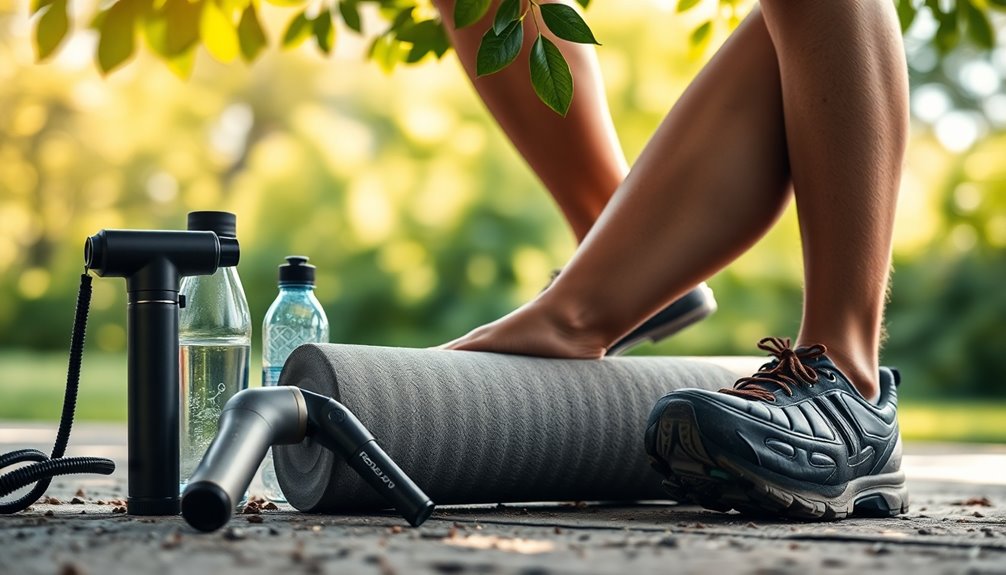
Cycling places significant stress on key muscle groups, making targeted recovery vital for peak performance. Focusing on these areas helps reduce soreness and enhances your cycling training effectiveness.
Here are four key muscle groups to prioritize during recovery:
- Achilles Tendon – Important for pedaling efficiency.
- Hamstrings – Significant for leg power and flexibility.
- IT Band – Helps maintain proper knee alignment.
- Glutes – Essential for overall strength and stability.
Utilizing a foam roller as a recovery tool can relieve tightness in these areas.
Incorporating mobility sessions will guarantee a full range of motion and prevent imbalances. Regular assessments of these muscle groups will help you tailor your recovery routine, ultimately improving your performance on the bike.
Post-Race Recovery Steps
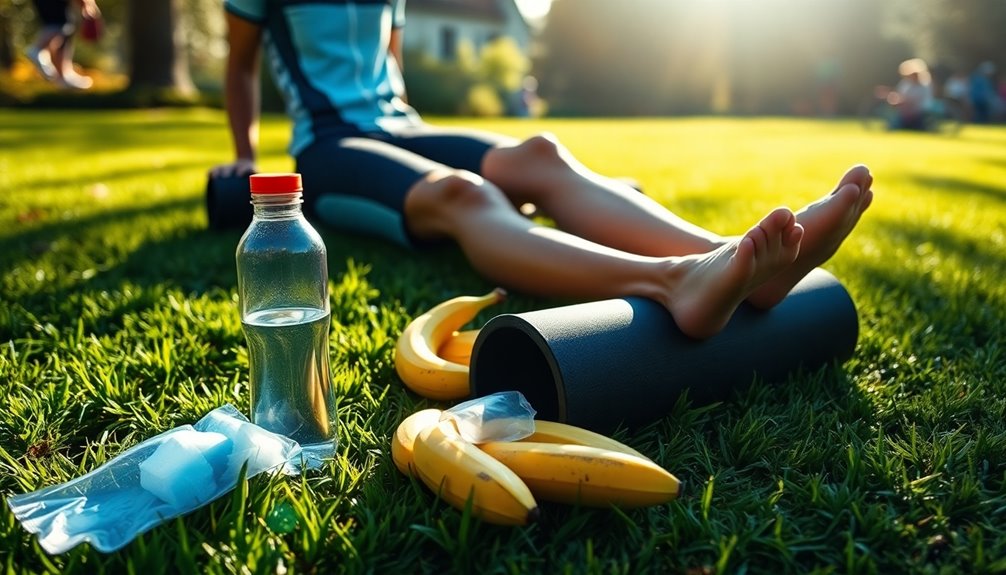
After focusing on key muscle groups for recovery, it's time to shift your attention to the immediate steps needed post-race.
First, prioritize hydration by drinking water and simple sugars to quickly replenish your energy levels.
Within 30 minutes, grab a post-race snack that contains 20-30g of protein and 30-50g of carbohydrates to kickstart muscle repair.
Don't skip a massage from a qualified massage therapist within the first few hours; this helps relieve muscle tension and boosts circulation.
Also, engage in stretching and foam rolling to alleviate stiffness and enhance flexibility in those key muscle groups.
Finally, prioritize consistent sleep—aim for 8-9 hours each night to optimize your recovery and performance moving forward.
Frequently Asked Questions
What Is the 75 Rule in Cycling?
The 75 Rule in cycling suggests you keep your training intensity at or below 75% of your maximum heart rate during recovery rides. This helps promote ideal recovery without stressing your body further.
By following this guideline, you enhance blood flow, aid muscle recovery, and minimize fatigue.
Aim for recovery rides lasting 30 to 60 minutes at low intensity to maximize benefits, maintaining fitness while allowing your body to recuperate effectively.
How Do Pro Cyclists Recover so Fast?
Did you know that pro cyclists aim for 8-9 hours of sleep each night? That's just one aspect of their rapid recovery.
They prioritize structured rest days and low-intensity rides to keep muscles active without straining them.
Advanced recovery tools like compression systems and electrical stimulation enhance blood flow, while proper nutrition—carbs and proteins within 30 minutes post-ride—optimizes muscle repair.
Regular sports massages and foam rolling further boost their recovery efficiency.
How to Recover From a 100 Mile Bike Ride?
After a 100-mile bike ride, you need to focus on hydration and nutrition.
Drink 16-24 ounces of electrolyte-rich fluids within the first hour to replenish lost salts.
Within 30 minutes, eat a recovery meal with a 3:1 ratio of carbohydrates to protein, like a smoothie.
The next day, engage in light cycling or walking to promote blood flow.
Don't forget to schedule a rest day and incorporate foam rolling and stretching for tight muscles.
How Long Should a Recovery Ride Be Cycling?
A recovery ride's length can feel short yet essential. Aim for 30 to 90 minutes, keeping it easy and light.
You want to encourage blood flow without pushing your limits, so stay in Zone 1 where conversation flows freely. After tough training, these rides help flush out soreness and maintain muscle activity.
Conclusion
In the grand adventure of cycling, recovery isn't just important; it's the secret sauce that transforms you from a mere rider into a cycling legend! Embrace every rest day, savor that nutritious meal, and let sleep rejuvenate your spirit like a magical spell. With the right techniques and tools, you'll bounce back stronger than ever, ready to conquer mountains and claim victories. Don't underestimate recovery—it's your ticket to greatness, and you deserve every glorious moment of it!
